Homogenization of very rough three - dimensional interfaces for the poroelasticity theory with biot’s model
Abstract. In this paper, we carry out the homogenization of a very rough threedimensional interface separating two dissimilar generally anisotropic poroelastic solids
modeled by the Biot theory. The very rough interface is assumed to be a cylindrical surface that rapidly oscillates between two parallel planes, and the motion is time-harmonic.
Using the homogenization method with the matrix formulation of the poroelasicity theory,
the explicit homogenized equations have been derived. Since the obtained homogenized
equations are totally explicit, they are very convenient for solving various practical problems. As an example proving this, the reflection and transmission of SH waves at a very
rough interface of tooth-comb type are considered. The closed-form analytical expressions
of the reflection and transmission coefficients have been derived. Based on them, the effect of the incident angle and some material parameters on the reflection and transmission
coefficients are examined numerically.
Keywords: homogenization; homogenized equations; very rough interfaces; fluid-saturated
porous media.
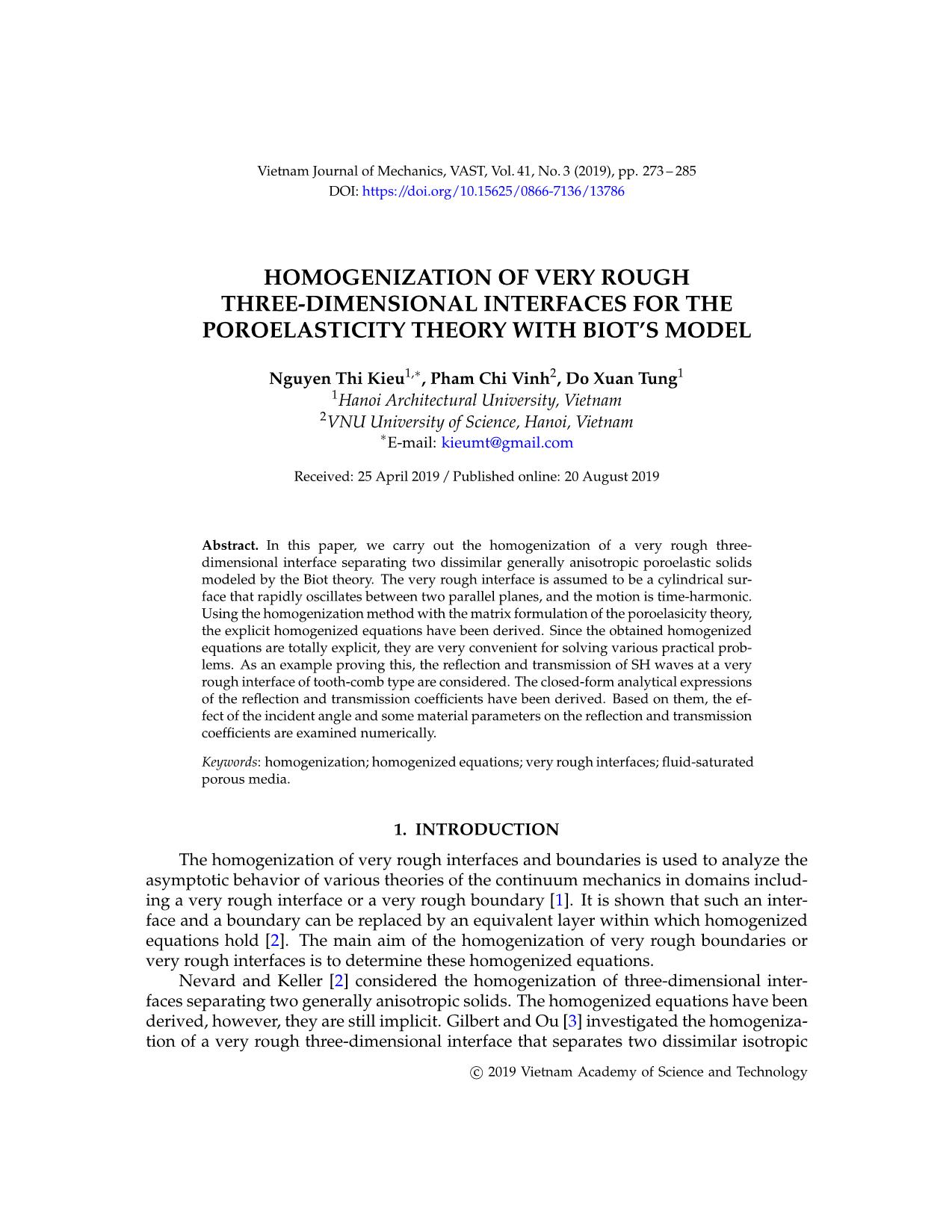
Trang 1
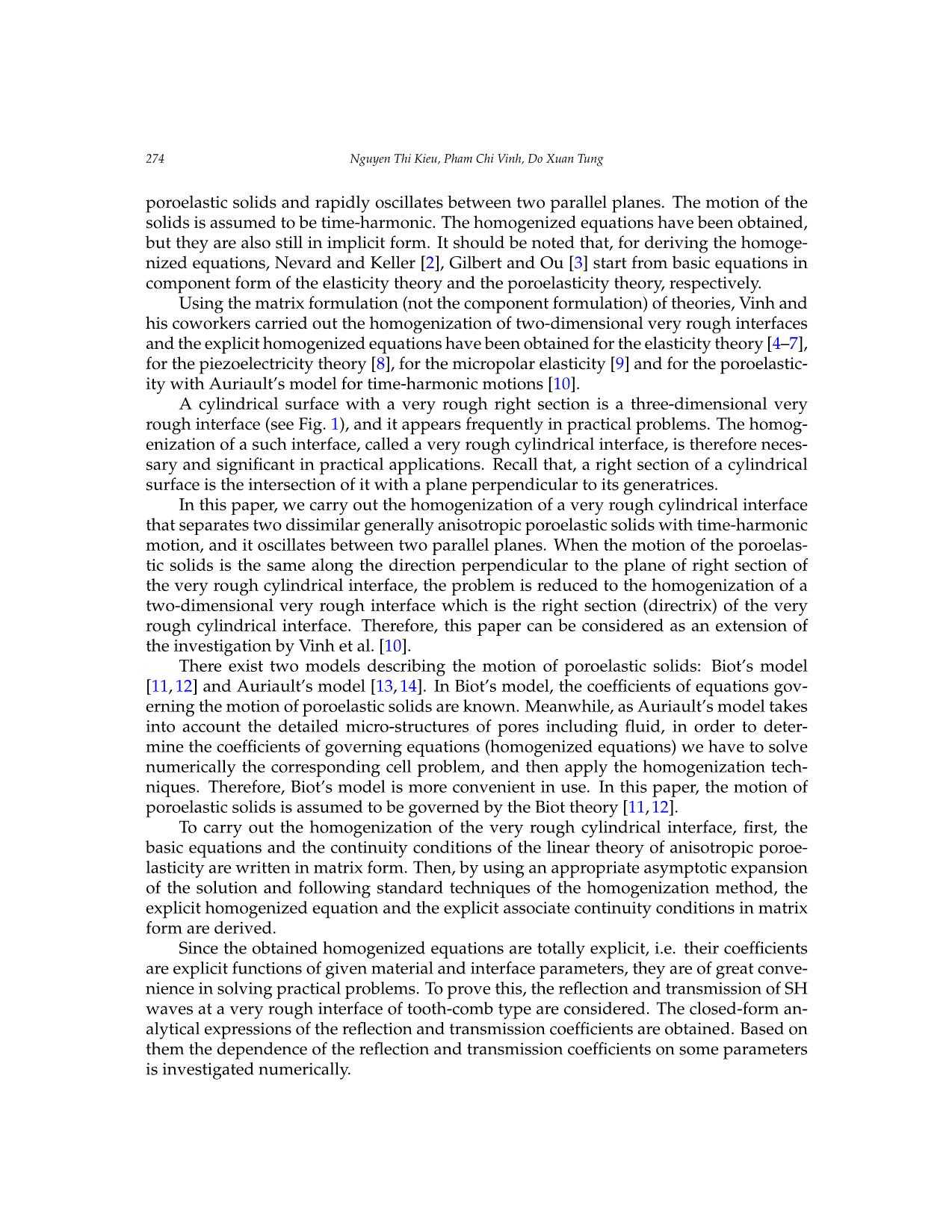
Trang 2
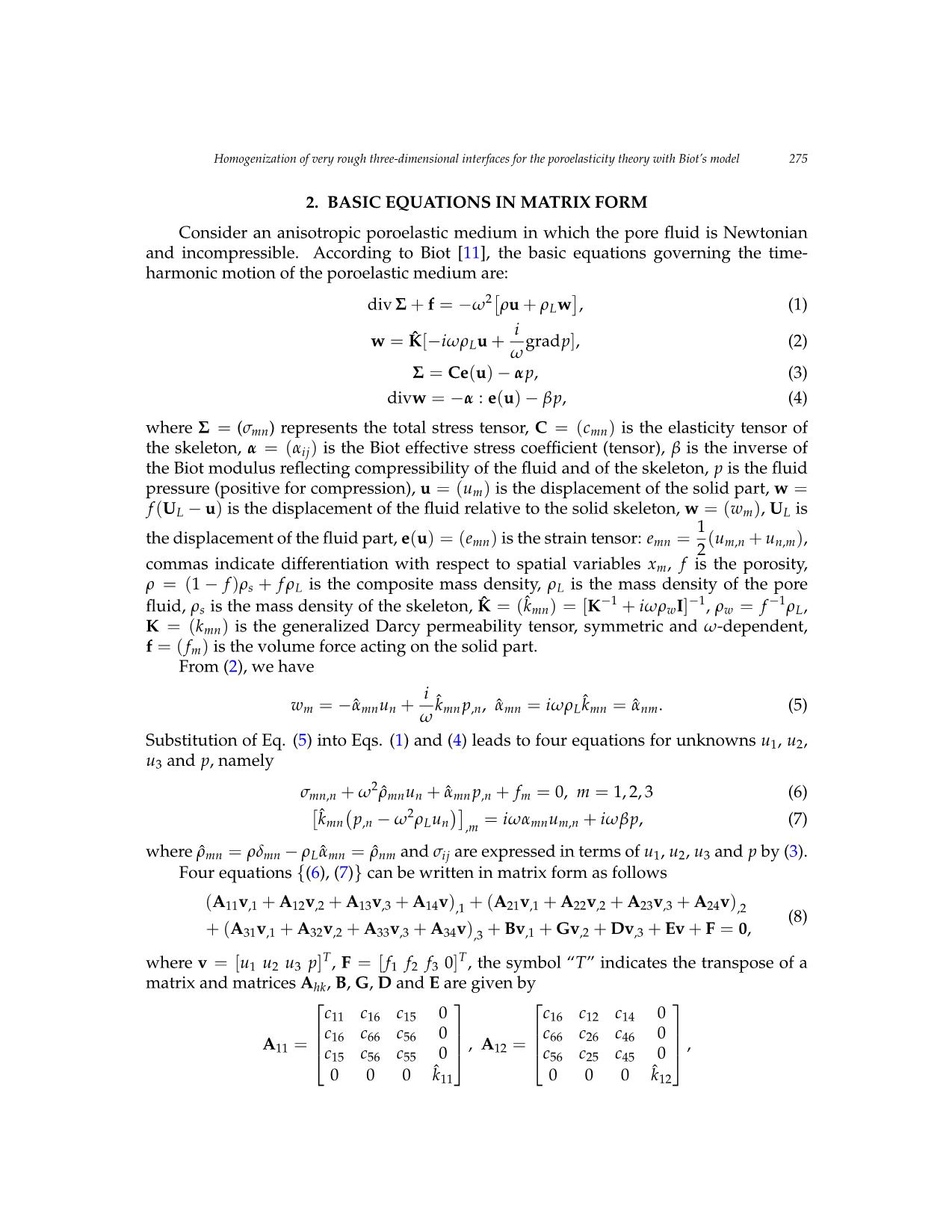
Trang 3
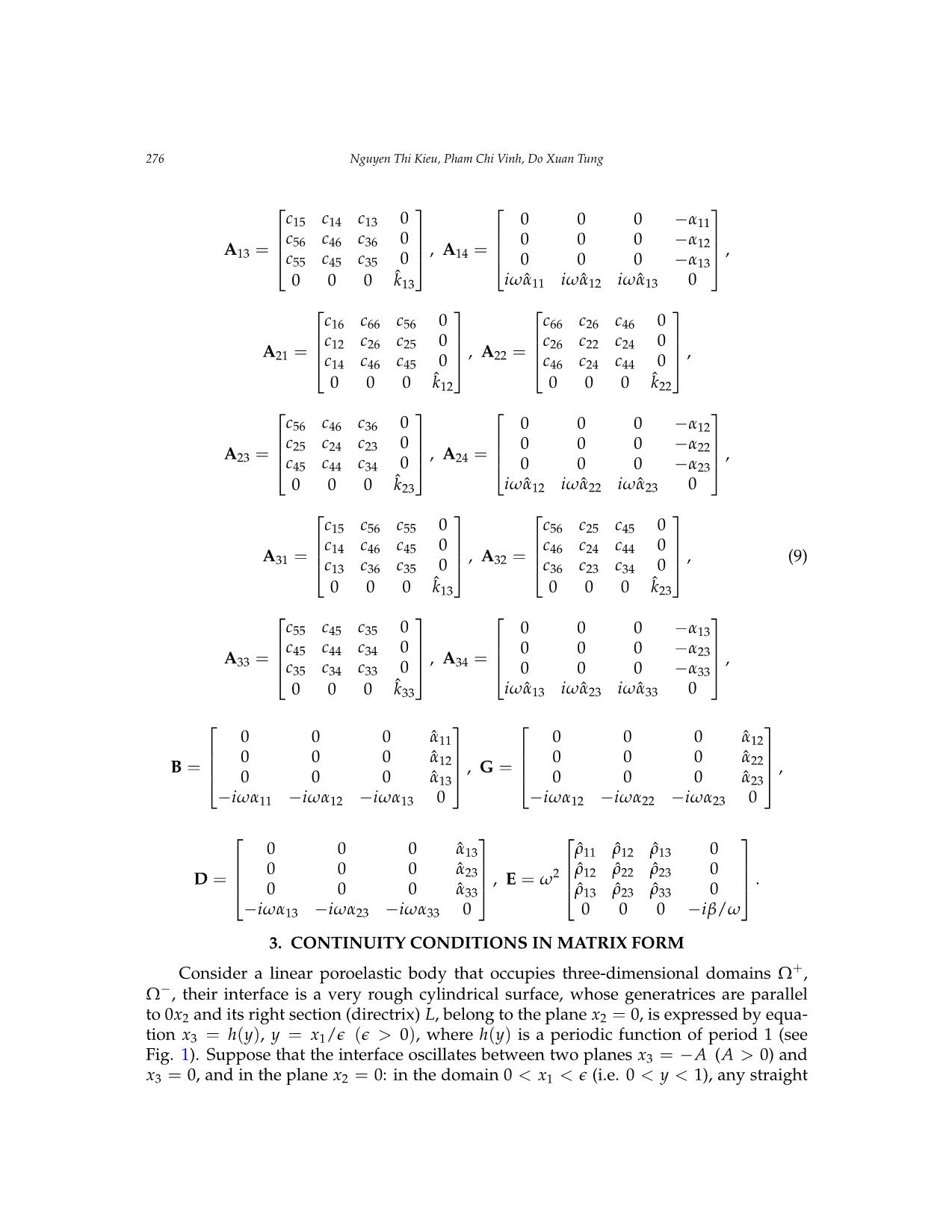
Trang 4
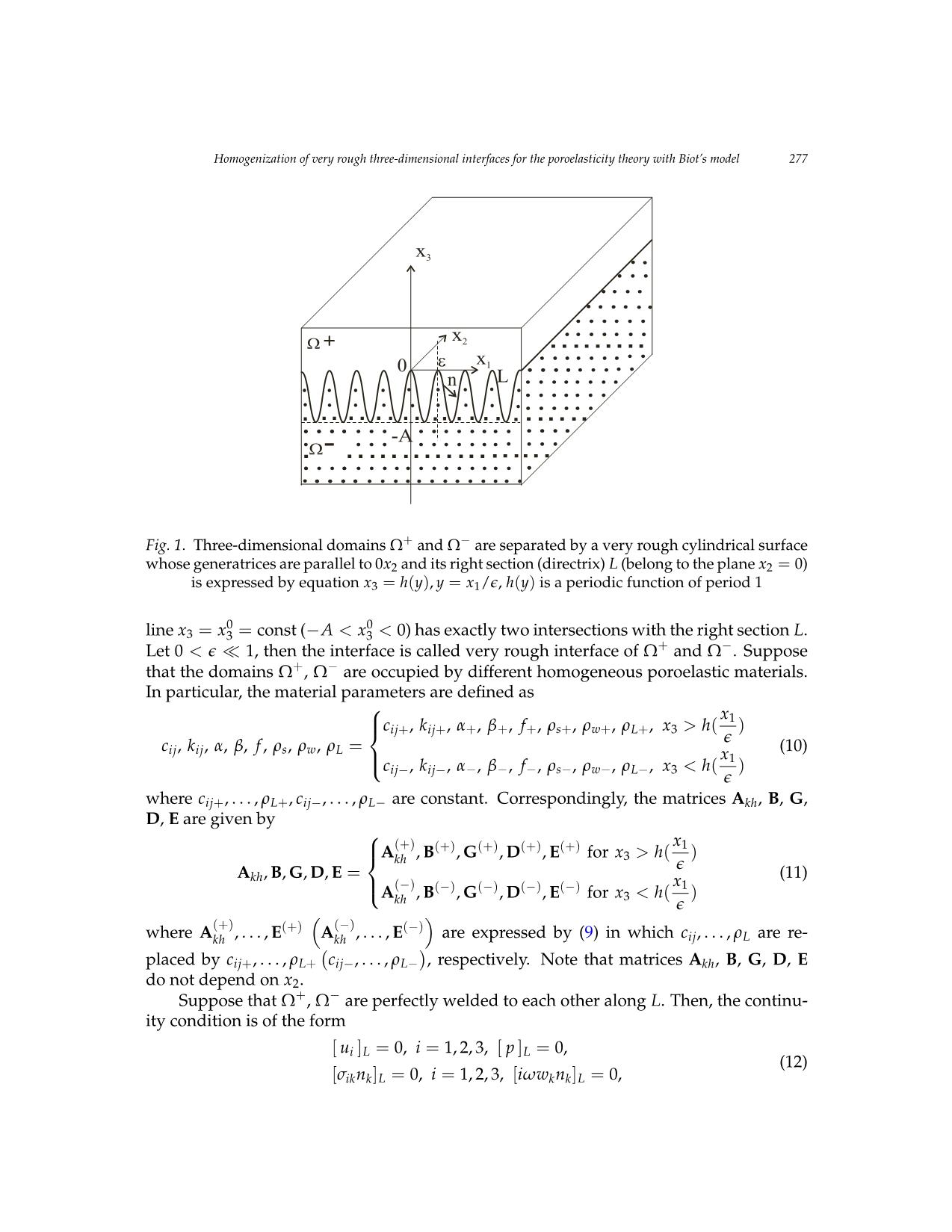
Trang 5
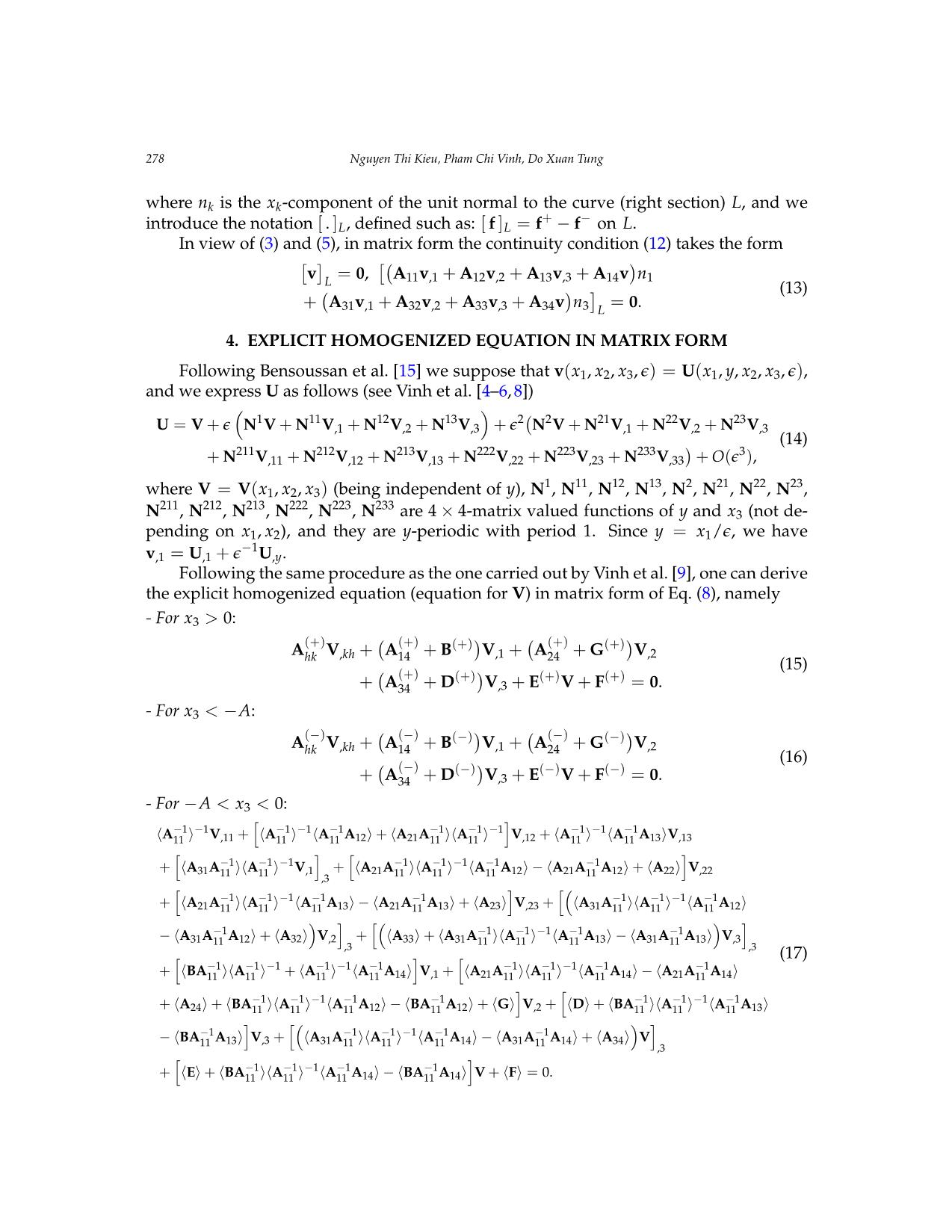
Trang 6
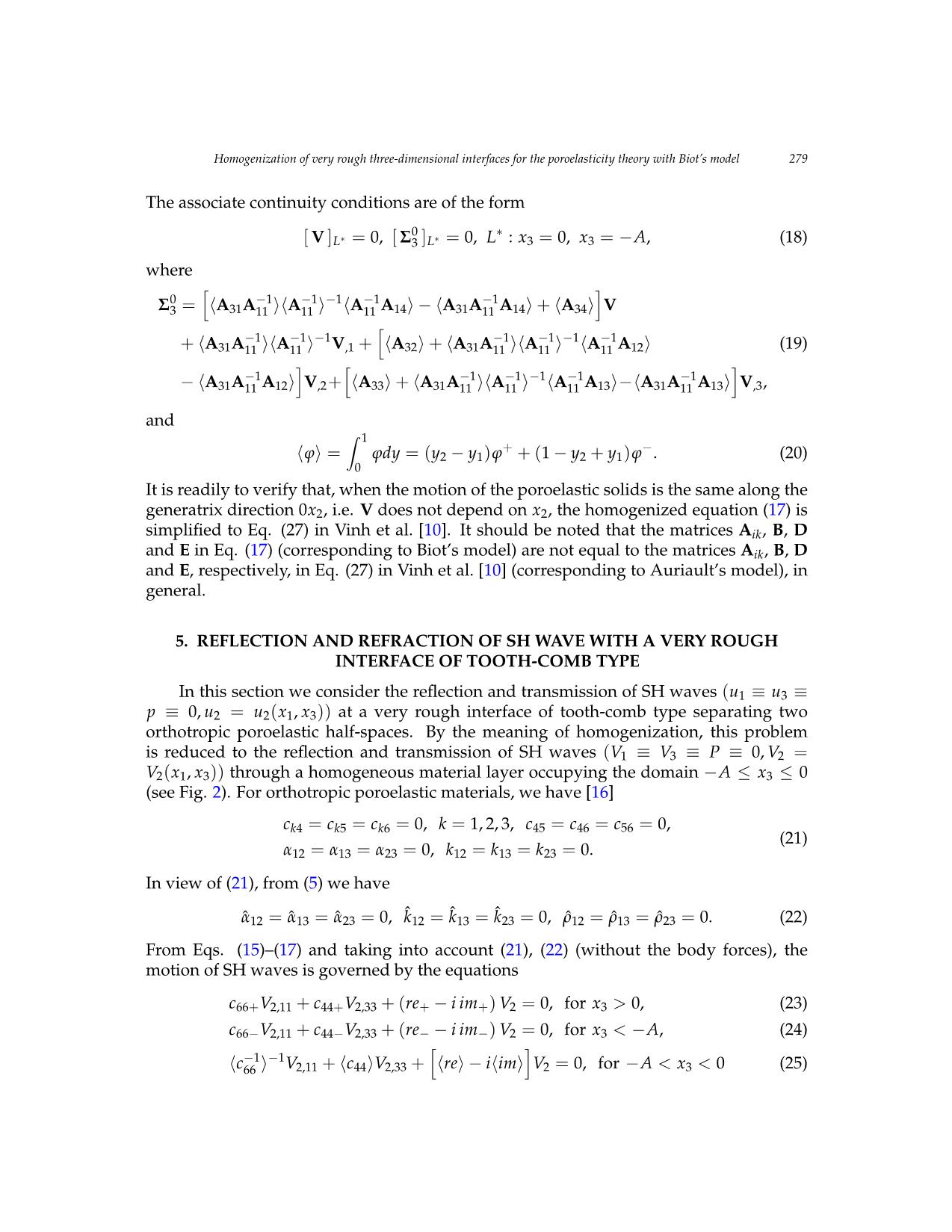
Trang 7
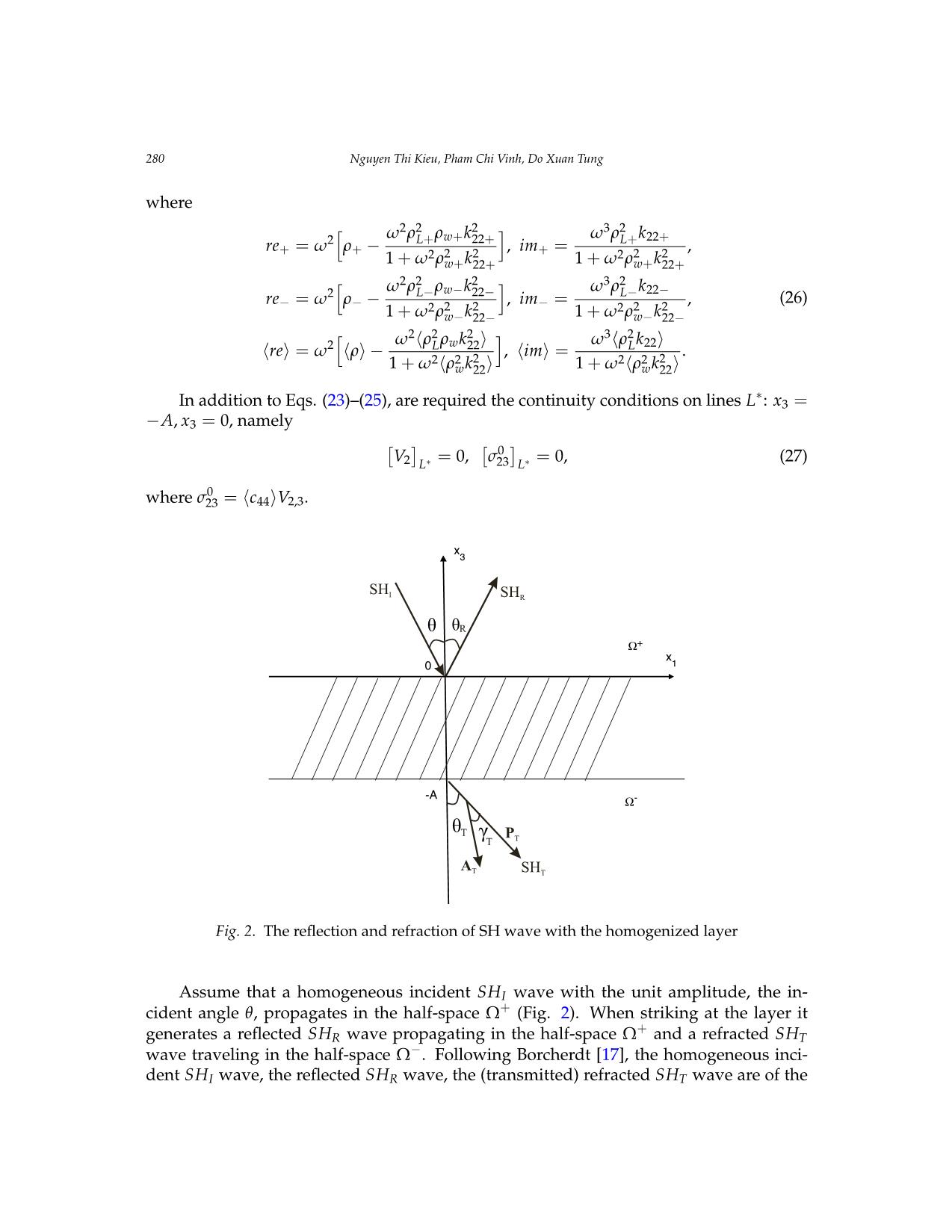
Trang 8
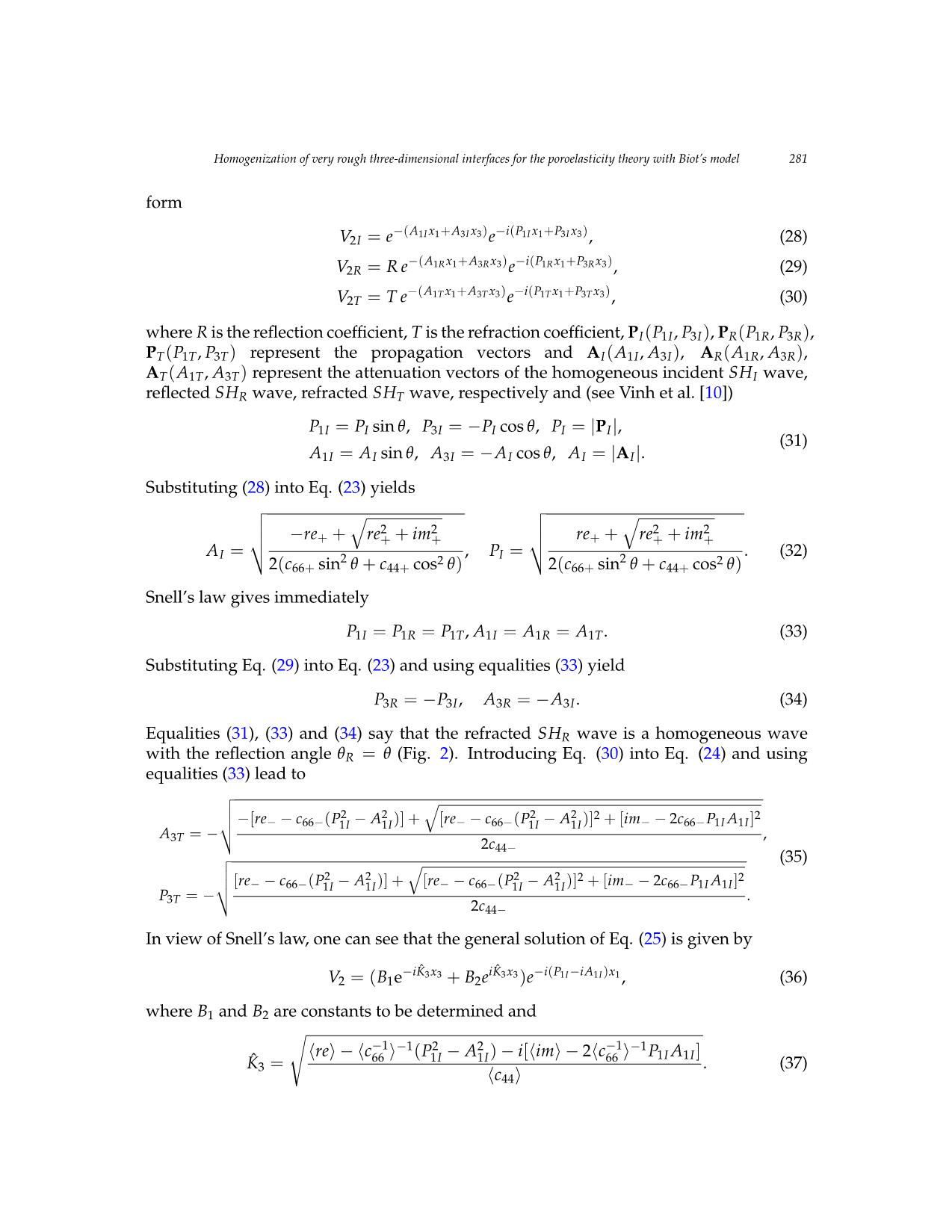
Trang 9
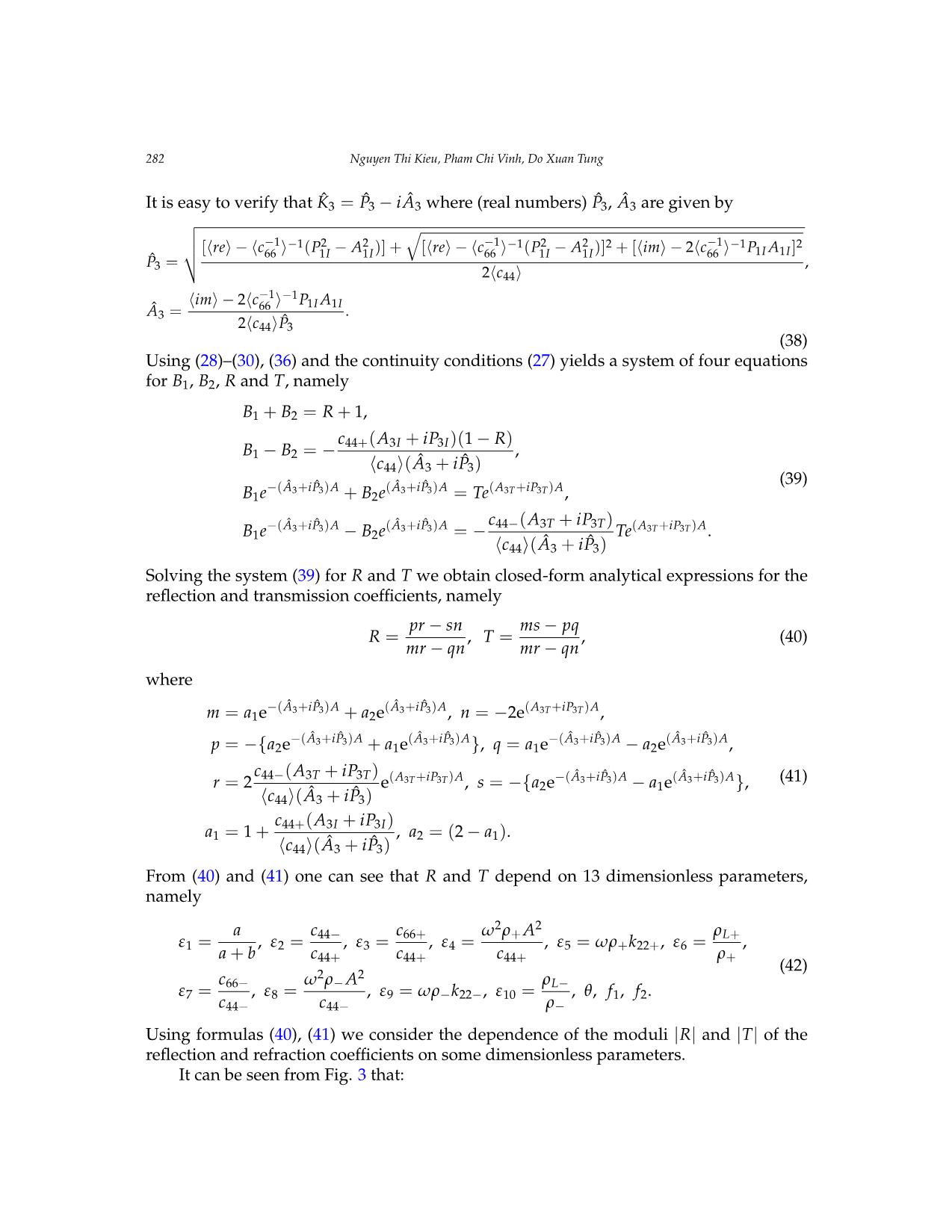
Trang 10
Tải về để xem bản đầy đủ
Tóm tắt nội dung tài liệu: Homogenization of very rough three - dimensional interfaces for the poroelasticity theory with biot’s model
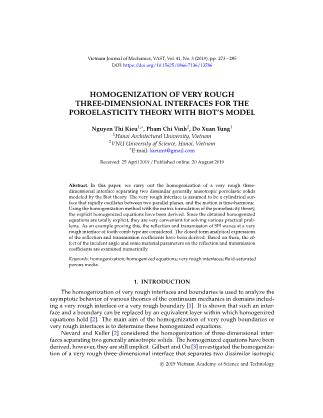
Vietnam Journal of Mechanics, VAST, Vol.41, No. 3 (2019), pp. 273 – 285
DOI: https://doi.org/10.15625/0866-7136/13786
HOMOGENIZATION OF VERY ROUGH
THREE-DIMENSIONAL INTERFACES FOR THE
POROELASTICITY THEORY WITH BIOT’S MODEL
Nguyen Thi Kieu1,∗, Pham Chi Vinh2, Do Xuan Tung1
1Hanoi Architectural University, Vietnam
2VNU University of Science, Hanoi, Vietnam
∗E-mail: kieumt@gmail.com
Received: 25 April 2019 / Published online: 20 August 2019
Abstract. In this paper, we carry out the homogenization of a very rough three-
dimensional interface separating two dissimilar generally anisotropic poroelastic solids
modeled by the Biot theory. The very rough interface is assumed to be a cylindrical sur-
face that rapidly oscillates between two parallel planes, and the motion is time-harmonic.
Using the homogenization method with the matrix formulation of the poroelasicity theory,
the explicit homogenized equations have been derived. Since the obtained homogenized
equations are totally explicit, they are very convenient for solving various practical prob-
lems. As an example proving this, the reflection and transmission of SH waves at a very
rough interface of tooth-comb type are considered. The closed-form analytical expressions
of the reflection and transmission coefficients have been derived. Based on them, the ef-
fect of the incident angle and some material parameters on the reflection and transmission
coefficients are examined numerically.
Keywords: homogenization; homogenized equations; very rough interfaces; fluid-saturated
porous media.
1. INTRODUCTION
The homogenization of very rough interfaces and boundaries is used to analyze the
asymptotic behavior of various theories of the continuum mechanics in domains includ-
ing a very rough interface or a very rough boundary [1]. It is shown that such an inter-
face and a boundary can be replaced by an equivalent layer within which homogenized
equations hold [2]. The main aim of the homogenization of very rough boundaries or
very rough interfaces is to determine these homogenized equations.
Nevard and Keller [2] considered the homogenization of three-dimensional inter-
faces separating two generally anisotropic solids. The homogenized equations have been
derived, however, they are still implicit. Gilbert and Ou [3] investigated the homogeniza-
tion of a very rough three-dimensional interface that separates two dissimilar isotropic
c 2019 Vietnam Academy of Science and Technology
274 Nguyen Thi Kieu, Pham Chi Vinh, Do Xuan Tung
poroelastic solids and rapidly oscillates between two parallel planes. The motion of the
solids is assumed to be time-harmonic. The homogenized equations have been obtained,
but they are also still in implicit form. It should be noted that, for deriving the homoge-
nized equations, Nevard and Keller [2], Gilbert and Ou [3] start from basic equations in
component form of the elasticity theory and the poroelasticity theory, respectively.
Using the matrix formulation (not the component formulation) of theories, Vinh and
his coworkers carried out the homogenization of two-dimensional very rough interfaces
and the explicit homogenized equations have been obtained for the elasticity theory [4–7],
for the piezoelectricity theory [8], for the micropolar elasticity [9] and for the poroelastic-
ity with Auriault’s model for time-harmonic motions [10].
A cylindrical surface with a very rough right section is a three-dimensional very
rough interface (see Fig.1), and it appears frequently in practical problems. The homog-
enization of a such interface, called a very rough cylindrical interface, is therefore neces-
sary and significant in practical applications. Recall that, a right section of a cylindrical
surface is the intersection of it with a plane perpendicular to its generatrices.
In this paper, we carry out the homogenization of a very rough cylindrical interface
that separates two dissimilar generally anisotropic poroelastic solids with time-harmonic
motion, and it oscillates between two parallel planes. When the motion of the poroelas-
tic solids is the same along the direction perpendicular to the plane of right section of
the very rough cylindrical interface, the problem is reduced to the homogenization of a
two-dimensional very rough interface which is the right section (directrix) of the very
rough cylindrical interface. Therefore, this paper can be considered as an extension of
the investigation by Vinh et al. [10].
There exist two models describing the motion of poroelastic solids: Biot’s model
[11, 12] and Auriault’s model [13, 14]. In Biot’s model, the coefficients of equations gov-
erning the motion of poroelastic solids are known. Meanwhile, as Auriault’s model takes
into account the detailed micro-structures of pores including fluid, in order to deter-
mine the coefficients of governing equations (homogenized equations) we have to solve
numerically the ... = U,1 + e U,y.
Following the same procedure as the one carried out by Vinh et al. [9], one can derive
the explicit homogenized equation (equation for V) in matrix form of Eq. (8), namely
- For x3 > 0:
(+) � (+) (+) � (+) (+)
A V,kh + A + B V,1 + A + G V,2
hk 14 24 (15)
� (+) (+) (+) (+)
+ A34 + D V,3 + E V + F = 0.
- For x3 < −A:
(−) � (−) (−) � (−) (−)
A V,kh + A + B V,1 + A + G V,2
hk 14 24 (16)
� (−) (−) (−) (−)
+ A34 + D V,3 + E V + F = 0.
- For −A < x3 < 0:
−1 −1 h −1 −1 −1 −1 −1 −1i −1 −1 −1
hA11 i V,11 + hA11 i hA11 A12i + hA21A11 ihA11 i V,12 + hA11 i hA11 A13iV,13
h −1 −1 −1 i h −1 −1 −1 −1 −1 i
+ hA31A11 ihA11 i V,1 + hA21A11 ihA11 i hA11 A12i − hA21A11 A12i + hA22i V,22
,3
h −1 −1 −1 −1 −1 i h −1 −1 −1 −1
+ hA21A11 ihA11 i hA11 A13i − hA21A11 A13i + hA23i V,23 + hA31A11 ihA11 i hA11 A12i
−1 i h −1 −1 −1 −1 −1 i
− hA31A11 A12i + hA32i V,2 + hA33i + hA31A11 ihA11 i hA11 A13i − hA31A11 A13i V,3
,3 ,3 (17)
h −1 −1 −1 −1 −1 −1 i h −1 −1 −1 −1 −1
+ hBA11 ihA11 i + hA11 i hA11 A14i V,1 + hA21A11 ihA11 i hA11 A14i − hA21A11 A14i
−1 −1 −1 −1 −1 i h −1 −1 −1 −1
+ hA24i + hBA11 ihA11 i hA11 A12i − hBA11 A12i + hGi V,2 + hDi + hBA11 ihA11 i hA11 A13i
−1 i h −1 −1 −1 −1 −1 i
− hBA11 A13i V,3 + hA31A11 ihA11 i hA11 A14i − hA31A11 A14i + hA34i V
,3
h −1 −1 −1 −1 −1 i
+ hEi + hBA11 ihA11 i hA11 A14i − hBA11 A14i V + hFi = 0.
Homogenization of very rough three-dimensional interfaces for the poroelasticity theory with Biot’s model 279
The associate continuity conditions are of the form
0 ∗
[ V ]L∗ = 0, [ Σ3 ]L∗ = 0, L : x3 = 0, x3 = −A, (18)
where
0 h −1 −1 −1 −1 −1 i
Σ3 = hA31A11 ihA11 i hA11 A14i − hA31A11 A14i + hA34i V
−1 −1 −1 h −1 −1 −1 −1
+ hA31A11 ihA11 i V,1 + hA32i + hA31A11 ihA11 i hA11 A12i (19)
−1 i h −1 −1 −1 −1 −1 i
− hA31A11 A12i V,2+ hA33i + hA31A11 ihA11 i hA11 A13i−hA31A11 A13i V,3,
and
Z 1
+ −
hϕi = ϕdy = (y2 − y1)ϕ + (1 − y2 + y1)ϕ . (20)
0
It is readily to verify that, when the motion of the poroelastic solids is the same along the
generatrix direction 0x2, i.e. V does not depend on x2, the homogenized equation (17) is
simplified to Eq. (27) in Vinh et al. [10]. It should be noted that the matrices Aik, B, D
and E in Eq. (17) (corresponding to Biot’s model) are not equal to the matrices Aik, B, D
and E, respectively, in Eq. (27) in Vinh et al. [10] (corresponding to Auriault’s model), in
general.
5. REFLECTION AND REFRACTION OF SH WAVE WITH A VERY ROUGH
INTERFACE OF TOOTH-COMB TYPE
In this section we consider the reflection and transmission of SH waves (u1 ≡ u3 ≡
p ≡ 0, u2 = u2(x1, x3)) at a very rough interface of tooth-comb type separating two
orthotropic poroelastic half-spaces. By the meaning of homogenization, this problem
is reduced to the reflection and transmission of SH waves (V1 ≡ V3 ≡ P ≡ 0, V2 =
V2(x1, x3)) through a homogeneous material layer occupying the domain −A ≤ x3 ≤ 0
(see Fig.2). For orthotropic poroelastic materials, we have [16]
ck4 = ck5 = ck6 = 0, k = 1, 2, 3, c45 = c46 = c56 = 0,
(21)
α12 = α13 = α23 = 0, k12 = k13 = k23 = 0.
In view of (21), from (5) we have
αˆ 12 = αˆ 13 = αˆ 23 = 0, kˆ12 = kˆ13 = kˆ23 = 0, ρˆ12 = ρˆ13 = ρˆ23 = 0. (22)
From Eqs. (15)–(17) and taking into account (21), (22) (without the body forces), the
motion of SH waves is governed by the equations
c66+V2,11 + c44+V2,33 + (re+ − i im+) V2 = 0, for x3 > 0, (23)
c66−V2,11 + c44−V2,33 + (re− − i im−) V2 = 0, for x3 < −A, (24)
−1 −1 h i
hc66 i V2,11 + hc44iV2,33 + hrei − ihimi V2 = 0, for −A < x3 < 0 (25)
280 Nguyen Thi Kieu, Pham Chi Vinh, Do Xuan Tung
where
2 2 2 3 2
h ω ρ ρw+k i ω ρ k22+
re = ω2 ρ − L+ 22+ , im = L+ ,
+ + 2 2 2 + 2 2 2
1 + ω ρw+k22+ 1 + ω ρw+k22+
2 2 2 3 2
h ω ρ ρw−k i ω ρ k22−
re = ω2 ρ − L− 22− , im = L− , (26)
− − 2 2 2 − 2 2 2
1 + ω ρw−k22− 1 + ω ρw−k22−
2 2 2 3 2
h ω hρ ρwk i i ω hρ k i
hrei = ω2 hρi − L 22 , himi = L 22 .
2 2 2 2 2 2
1 + ω hρwk22i 1 + ω hρwk22i
∗
In addition to Eqs. (23)–(25), are required the continuity conditions on lines L : x3 =
−A, x3 = 0, namely
= 0 =
V2 L∗ 0, σ23 L∗ 0, (27)
0
where σ23 = hc44iV2,3.
Fig. 2. The reflection and refraction of SH wave with the homogenized layer
Assume that a homogeneous incident SHI wave with the unit amplitude, the in-
cident angle θ, propagates in the half-space Ω+ (Fig.2). When striking at the layer it
+
generates a reflected SHR wave propagating in the half-space Ω and a refracted SHT
wave traveling in the half-space Ω−. Following Borcherdt [17], the homogeneous inci-
dent SHI wave, the reflected SHR wave, the (transmitted) refracted SHT wave are of the
Homogenization of very rough three-dimensional interfaces for the poroelasticity theory with Biot’s model 281
form
−(A1I x1+A3I x3) −i(P1I x1+P3I x3)
V2I = e e , (28)
−(A1R x1+A3R x3) −i(P1R x1+P3R x3)
V2R = R e e , (29)
−(A1T x1+A3T x3) −i(P1T x1+P3T x3)
V2T = T e e , (30)
where R is the reflection coefficient, T is the refraction coefficient, PI (P1I, P3I ), PR(P1R, P3R),
PT(P1T, P3T) represent the propagation vectors and AI (A1I, A3I ), AR(A1R, A3R),
AT(A1T, A3T) represent the attenuation vectors of the homogeneous incident SHI wave,
reflected SHR wave, refracted SHT wave, respectively and (see Vinh et al. [10])
P1I = PI sin θ, P3I = −PI cos θ, PI = |PI |,
(31)
A1I = AI sin θ, A3I = −AI cos θ, AI = |AI |.
Substituting (28) into Eq. (23) yields
v q v q
u 2 2 u 2 2
u −re+ + re+ + im+ u re+ + re+ + im+
A = t , P = t . (32)
I 2 2 I 2 2
2(c66+ sin θ + c44+ cos θ) 2(c66+ sin θ + c44+ cos θ)
Snell’s law gives immediately
P1I = P1R = P1T, A1I = A1R = A1T. (33)
Substituting Eq. (29) into Eq. (23) and using equalities (33) yield
P3R = −P3I, A3R = −A3I. (34)
Equalities (31), (33) and (34) say that the refracted SHR wave is a homogeneous wave
with the reflection angle θR = θ (Fig.2). Introducing Eq. (30) into Eq. (24) and using
equalities (33) lead to
v
u q
u −[re − c (P2 − A2 )] + [re − c (P2 − A2 )]2 + [im − 2c P A ]2
t − 66− 1I 1I − 66− 1I 1I − 66− 1I 1I
A3T = − ,
2c44−
v (35)
u q
u [re − c (P2 − A2 )] + [re − c (P2 − A2 )]2 + [im − 2c P A ]2
t − 66− 1I 1I − 66− 1I 1I − 66− 1I 1I
P3T = − .
2c44−
In view of Snell’s law, one can see that the general solution of Eq. (25) is given by
−iKˆ3x3 iKˆ3x3 −i(P1I −iA1I )x1
V2 = (B1e + B2e )e , (36)
where B1 and B2 are constants to be determined and
s
−1 −1 2 2 −1 −1
hrei − hc66 i (P1I − A1I ) − i[himi − 2hc66 i P1I A1I ]
Kˆ3 = . (37)
hc44i
282 Nguyen Thi Kieu, Pham Chi Vinh, Do Xuan Tung
It is easy to verify that Kˆ3 = Pˆ3 − iAˆ 3 where (real numbers) Pˆ3, Aˆ 3 are given by
v
u q
u [hrei − hc−1i−1(P2 − A2 )] + [hrei − hc−1i−1(P2 − A2 )]2 + [himi − 2hc−1i−1P A ]2
t 66 1I 1I 66 1I 1I 66 1I 1I
Pˆ3 = ,
2hc44i
−1 −1
himi − 2hc66 i P1I A1I
Aˆ3 = .
2hc44iPˆ3
(38)
Using (28)–(30), (36) and the continuity conditions (27) yields a system of four equations
for B1, B2, R and T, namely
B1 + B2 = R + 1,
c44+(A3I + iP3I )(1 − R)
B1 − B2 = − ,
hc44i(Aˆ 3 + iPˆ3)
(39)
−(Aˆ3+iPˆ3)A (Aˆ3+iPˆ3)A (A3T +iP3T )A
B1e + B2e = Te ,
c (A + iP )
−(Aˆ3+iPˆ3)A (Aˆ3+iPˆ3)A 44− 3T 3T (A3T +iP3T )A
B1e − B2e = − Te .
hc44i(Aˆ 3 + iPˆ3)
Solving the system (39) for R and T we obtain closed-form analytical expressions for the
reflection and transmission coefficients, namely
pr − sn ms − pq
R = , T = , (40)
mr − qn mr − qn
where
−(Aˆ3+iPˆ3)A (Aˆ3+iPˆ3)A (A3T +iP3T )A
m = a1e + a2e , n = −2e ,
−(Aˆ3+iPˆ3)A (Aˆ3+iPˆ3)A −(Aˆ3+iPˆ3)A (Aˆ3+iPˆ3)A
p = −{a2e + a1e }, q = a1e − a2e ,
c (A + iP )
44− 3T 3T (A3T +iP3T )A −(Aˆ3+iPˆ3)A (Aˆ3+iPˆ3)A (41)
r = 2 e , s = −{a2e − a1e },
hc44i(Aˆ 3 + iPˆ3)
c44+(A3I + iP3I )
a1 = 1 + , a2 = (2 − a1).
hc44i(Aˆ 3 + iPˆ3)
From (40) and (41) one can see that R and T depend on 13 dimensionless parameters,
namely
2 2
a c44− c66+ ω ρ+ A ρL+
ε1 = , ε2 = , ε3 = , ε4 = , ε5 = ωρ+k22+, ε6 = ,
a + b c + c + c + ρ+
44 44 44 (42)
2 2
c66− ω ρ− A ρL−
ε7 = , ε8 = , ε9 = ωρ−k22−, ε10 = , θ, f1, f2.
c44− c44− ρ−
Using formulas (40), (41) we consider the dependence of the moduli |R| and |T| of the
reflection and refraction coefficients on some dimensionless parameters.
It can be seen from Fig.3 that:
Homogenization of very rough three-dimensional interfaces for the poroelasticity theory with Biot’s model 283
(i) When the incident angle θ0 increases, moduli |R|, |R0| increase and moduli |T|,
|T0| decrease, |R| |T0| in which |R|, |T|,(|R0|, |T0|) are the reflection, refrac-
tion coefficients with the rough interface, (without the rough interface) (see Fig. 3(a)).
(ii) The increasing of ε1, ε2 makes the reflection coefficient increasing and makes the
transmission coefficient decreasing (see Figs. 3(b), 3(c)).
(iii) In contrast, the increasing of ε4 makes the reflection coefficient decreasing and
makes the transmission coefficient increasing (see Fig. 3(d)).
1 1.6
|R|
|R|
|T| 1.5
|T|
|R | 1.4
0.8 0
|T | 1.3
| 0
0
0.6 1.2
|, |T
0
1.1
|R|, |T|
0.4 1
|R|, |T|, |R 0.9
0.2 0.8
0.7
0
0 10 20 30 40 θ 50 60 70 80 90 0.1 0.2 0.3 0.4 0.5 ε 0.6 0.7 0.8 0.9
0 0 1
ε = 0.3; ε = 1.6; ε = 1.3; ε = 1.5; ε = 1.6; ε = 0.6; θ = 60 ; ε = 1.2; ε = 1.3; ε = 1.5; ε = 1.6; ε = 0.6;
1 2 3 4 5 6 0 2 3 4 5 6
ε =1.8; ε =3.5; ε =1.1; ε =1.2; f = 0.1; f = 0.2 ε = 1.8; ε = 3.5; ε = 3.1; ε = 1.2; f = 0.8; f = 0.7
7 8 9 10 1 2 7 8 9 10 1 2
(a) (b)
(c) (d)
|R|
|R| |T|
1
|T| 1
0.8 0.8
0.6 0.6
|R|, |T|
|R|, |T|
0.4 0.4
0.2 0.2
0 0
0.5 1 ε 1.5 2 2.5 3 0.5 1 ε 1.5 2 2.5 3
2 4
ε =0.7; ε =1.3; ε =0.2; ε =1.6; ε =0.6; ε =1.8; ε =0.7; ε =1.3; ε =1.5; ε =2.6; ε =0.6; ε =1.8;
1 3 4 5 6 7 1 2 3 5 6 7
ε =3.5; ε =1.1; ε =0.8; f = 0.1; f = 0.2; θ=60o ε =2.1; ε =0.1; ε =1.2; f = 0.3; f = 0.2; θ=30o
8 9 10 1 2 8 9 10 1 2
(c) (d)
Fig. 3. The dependence of the moduli |R| and |T| of the reflection
and transmission coefficients on θ0 (a), ε1 (b), ε2 (c), ε4 (d)
6. CONCLUSIONS
In this paper the homogenization of a very rough cylindrical interface that separates
two dissimilar generally anisotropic poroelastic solids with time-harmonic motion, and
oscillates rapidly between two parallel planes is investigated. The explicit homogenized
equation in matrix form has been derived by applying the homogenization method. Since
the obtained homogenized equations are fully explicit, they are a powerful tool for inves-
tigating various practical problems. As an example, the reflection and transmission of
284 Nguyen Thi Kieu, Pham Chi Vinh, Do Xuan Tung
SH waves at a very rough interface of tooth-comb type are considered. The closed-form
analytical expressions of the reflection and transmission coefficients have been obtained.
Employing them, the effect of the incident angle and the material parameters on the re-
flection and transmission coefficients is investigated numerically.
ACKNOWLEDGMENTS
The work was supported by the Vietnam National Foundation for Science and Tech-
nology Development (NAFOSTED) under Grant No. 107.02-2017.07.
REFERENCES
[1] W. Kohler, G. Papanicolaou, and S. Varadhan. Boundary and interface problems in re-
gions with very rough boundaries. In Multiple Scattering and Waves in Random Media, (1981),
pp. 165–197.
[2] J. Nevard and J. B. Keller. Homogenization of rough boundaries and inter-
faces. SIAM Journal on Applied Mathematics, 57, (6), (1997), pp. 1660–1686.
https://doi.org/10.1137/s0036139995291088.
[3] R. P. Gilbert and M.-J. Ou. Acoustic wave propagation in a composite of two different
poroelastic materials with a very rough periodic interface: a homogenization approach.
International Journal for Multiscale Computational Engineering, 1, (4), (2003), pp. 431–440.
https://doi.org/10.1142/9789812704405 0024.
[4] P. C. Vinh and D. X. Tung. Homogenized equations of the linear elasticity in two-dimensional
domains with very rough interfaces. Mechanics Research Communications, 37, (3), (2010),
pp. 285–288. https://doi.org/10.1016/j.mechrescom.2010.02.006.
[5] P. C. Vinh and D. X. Tung. Homogenization of rough two-dimensional inter-
faces separating two anisotropic solids. Journal of Applied Mechanics, 78, (4), (2011).
https://doi.org/10.1115/1.4003722.
[6] P. C. Vinh and D. X. Tung. Homogenized equations of the linear elasticity theory in two-
dimensional domains with interfaces highly oscillating between two circles. Acta Mechanica,
218, (3-4), (2011), pp. 333–348. https://doi.org/10.1007/s00707-010-0426-2.
[7] D. X. Tung, P. C. Vinh, and N. K. Tung. Homogenization of an interface highly oscillating
between two concentric ellipses. Vietnam Journal of Mechanics, 34, (2), (2012), pp. 113–121.
https://doi.org/10.15625/0866-7136/34/2/926.
[8] P. C. Vinh and D. X. Tung. Homogenization of very rough interfaces separat-
ing two piezoelectric solids. Acta Mechanica, 224, (5), (2013), pp. 1077–1088.
https://doi.org/10.1007/s00707-012-0804-z.
[9] P. C. Vinh, V. T. N. Anh, D. X. Tung, and N. T. Kieu. Homogenization of very rough interfaces
for the micropolar elasticity theory. Applied Mathematical Modelling, 54, (2018), pp. 467–482.
https://doi.org/10.1016/j.apm.2017.09.039.
[10] P. C. Vinh, D. X. Tung, and N. T. Kieu. Homogenization of very rough two-dimensional inter-
faces separating two dissimilar poroelastic solids with time-harmonic motions. Mathematics
and Mechanics of Solids, 24, (5), (2019), pp. 1349–1367.
[11] M. A. Biot. Theory of propagation of elastic waves in a fluid-saturated porous solid. I. Low-
frequency range. The Journal of the Acoustical Society of America, 28, (2), (1956), pp. 168–178.
https://doi.org/10.1121/1.1908239.
[12] M. A. Biot. Mechanics of deformation and acoustic propagation in porous media. Journal of
Applied Physics, 33, (4), (1962), pp. 1482–1498. https://doi.org/10.1063/1.1728759.
Homogenization of very rough three-dimensional interfaces for the poroelasticity theory with Biot’s model 285
[13] J. L. Auriault. Dynamic behaviour of a porous medium saturated by a Newto-
nian fluid. International Journal of Engineering Science, 18, (6), (1980), pp. 775–785.
https://doi.org/10.1016/0020-7225(80)90025-7.
[14] J. L. Auriault, L. Borne, and R. Chambon. Dynamics of porous saturated media, checking of
the generalized law of Darcy. The Journal of the Acoustical Society of America, 77, (5), (1985),
pp. 1641–1650. https://doi.org/10.1121/1.391962.
[15] A. Bensoussan and J. L. Lions. Asymptotic analysis for periodic structures, Vol. 5. North-Holland,
Amsterdam, (1978). https://doi.org/10.1090/chel/374.
[16] T. C. T. Ting. Anisotropic elasticity: Theory and applications. Oxford University Press, NewYork,
(1996).
[17] R. D. Borcherdt. Viscoelastic waves in layered media. Cambridge University Press, (2009).
File đính kèm:
 homogenization_of_very_rough_three_dimensional_interfaces_fo.pdf
homogenization_of_very_rough_three_dimensional_interfaces_fo.pdf

